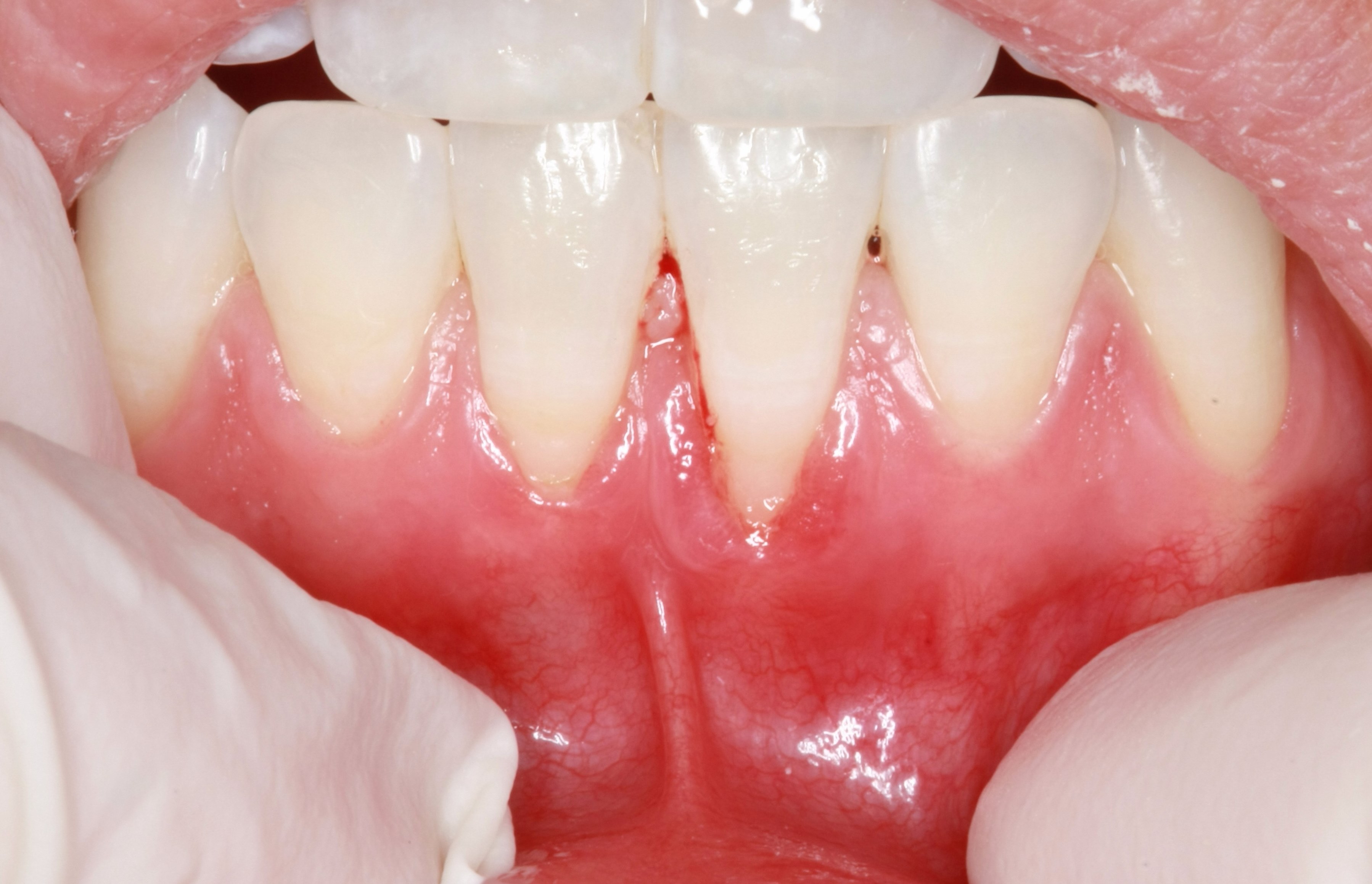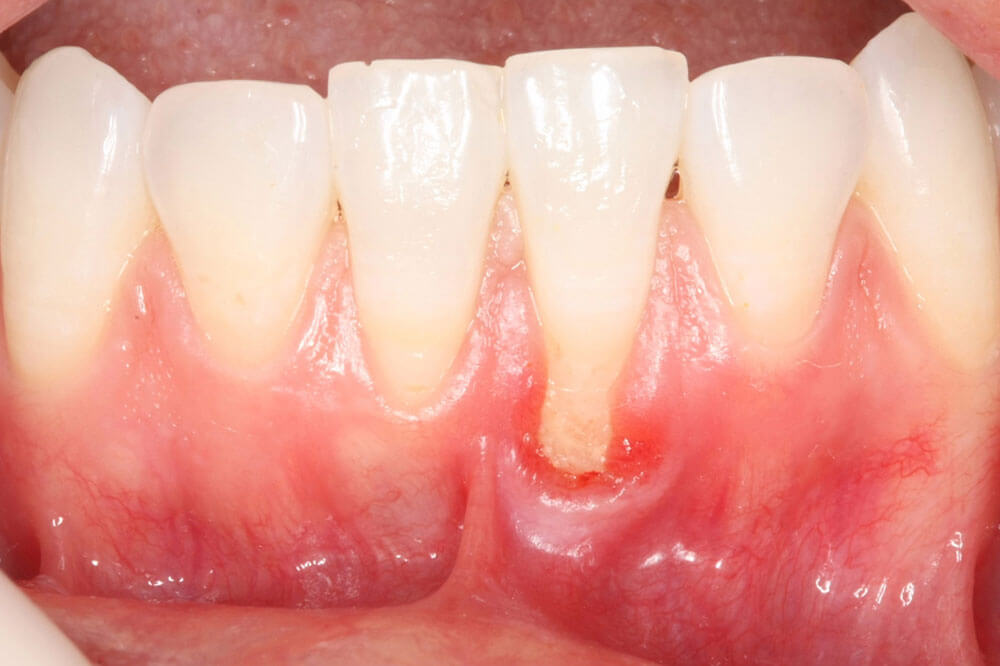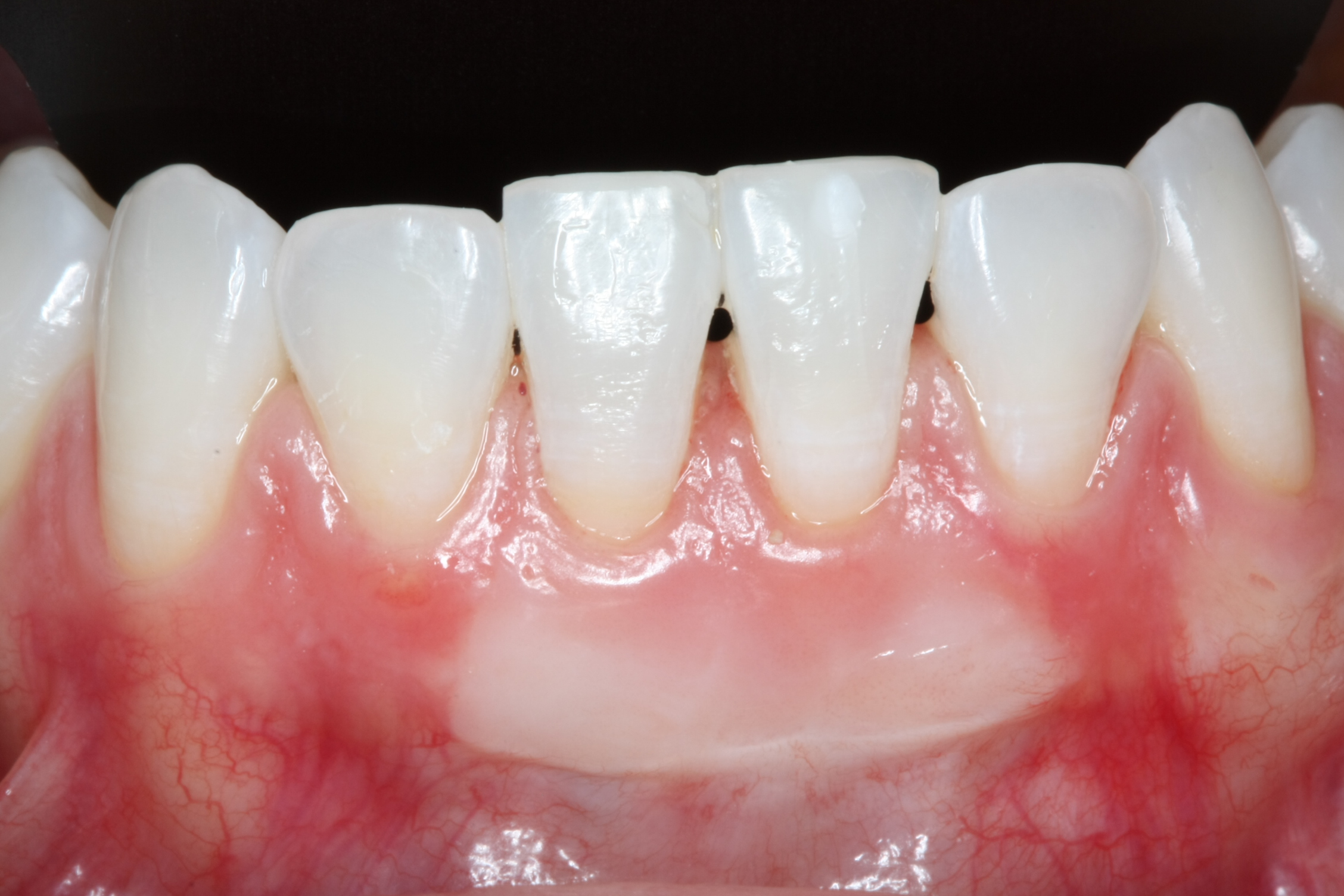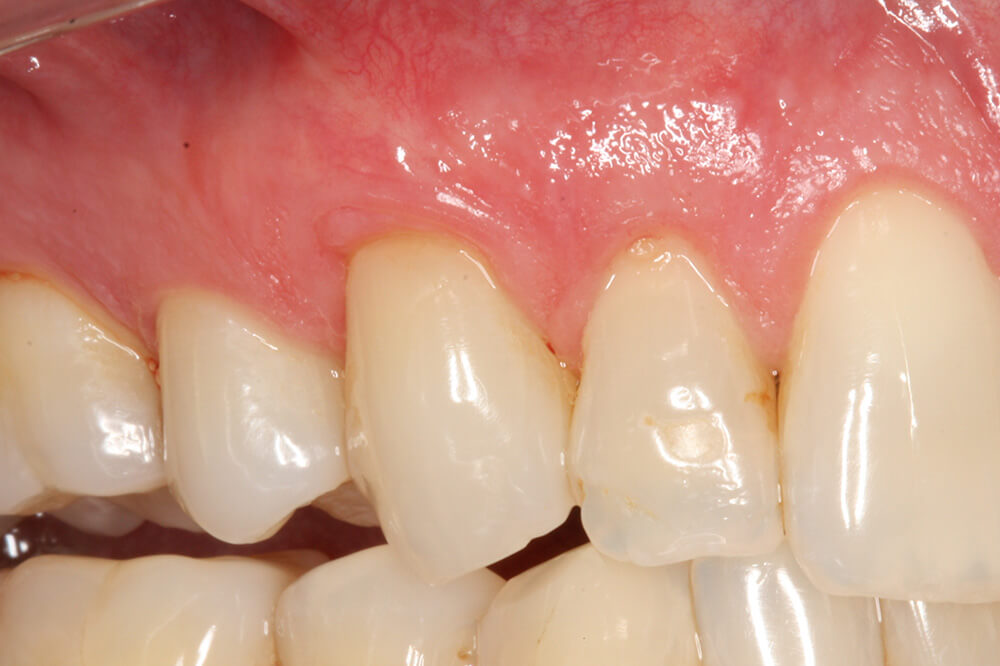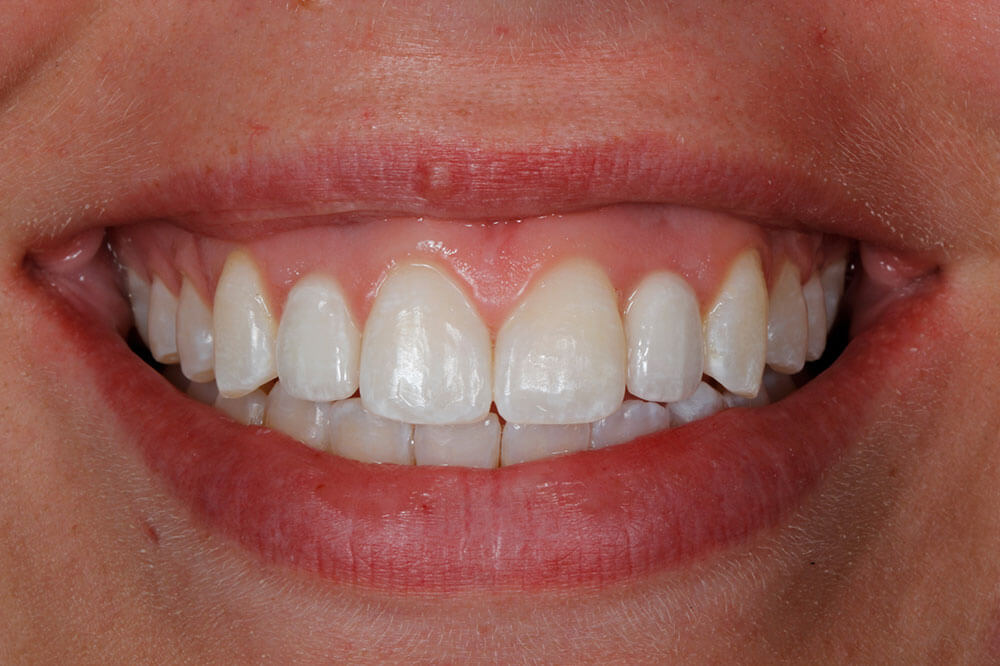When you have periodontal disease, the supporting tissue and bone is destroyed, forming “pockets” around the teeth. Over time, these pockets become deeper, providing a larger space for bacteria to live. Traditionally, gum disease is treated by eliminating these gum pockets and creating a clean environment around the tooth so that the tooth or teeth can be retained rather than lost. The infected gum tissue is trimmed away and uneven bone tissue recontoured. This procedure remains one of the most effective ways of treating gum disease.
Periodontal Pocket Reduction Surgery

Periodontal Regeneration Graft (Bone Grafting)
If the patient has severe bone loss surrounding existing teeth, Dr. Britten may recommend a regenerative procedure called Periodontal Regeneration Grafting. These procedures can reverse some of the damage by regenerating lost bone and tissue.
During this procedure, Dr. Britten accesses the deeper disease and removes the disease‐causing bacteria in a procedure called osseous surgery . Barrier membranes, bone grafts or tissue‐stimulating proteins can then be used to encourage your body’s natural ability to regenerate bone and tissue. The bone grafting material is placed in the bony defects around the teeth. A membrane may be used to cover and protect the bone graft. When healed, new bone will grow and attach to the teeth.
WATCH VIDEO
Gum Grafting
When recession of the gum tissue occurs, the body loses a natural defense against both bacterial penetration and trauma. When gum recession is a problem, gum reconstruction using grafting techniques is an excellent option.
When there is only minor recession, some healthy gum tissue often remains and protects the tooth, so that no treatment other than modifying home care practices is necessary. However, when no firm gum tissue remains, this leaves the roots of the teeth and the underlying bone relatively unprotected, which could result in root sensitivity, bacterial penetration, decay and even loss of teeth.
A gingival graft is designed to address these problems. A thin piece of tissue is taken from the roof of the mouth or gently moved over from adjacent areas to provide a stable band of attached gum tissue around the tooth. The gingival graft may be placed in such a way as to cover the exposed portion of the root, however, the main objective is to reestablish the protective barrier or layer of the gum around the tooth. Occasionally, the patient may need multiple procedures to achieve the ideal amount of root coverage.
Dr. Britten has trained in the latest minimally invasive techniques of gum grafting and can often perform the entire procedure through a pinhole incision.
Gingival Graft:
GINGIVAL GRAFT IMAGES

Restoring health and harmony—our connective tissue grafting procedures rejuvenate gum tissue, enhance aesthetics, and protect your smile for years to come!
FRENECTOMY
A frenectomy is a simple surgical procedure that removes or modifies a frenum—a small fold of tissue that can restrict movement in the mouth. At Britten Periodontics, we perform frenectomies to help improve oral function, reduce discomfort, and support orthodontic or periodontal treatment. This quick and effective procedure can enhance speech, ease tension on the gums, and promote better oral health.

Functional Crown Lengthening
Sometimes crown lengthening, removal of gum tissue, will be needed in order to perform a cosmetic or restorative procedure. This may be the case if a tooth is too far decayed, broken below the gum line, or has insufficient structure for restoration like a crown or bridge. In cases like this, Dr. Britten may be required to lower the gum and bone levels to expose more of the root surface so it can be restored. However, simply trimming back the gum line is not sufficient. Instead, Dr. Britten will need to reshape the gums and supporting bone to allow for adequate room to place a high quality restoration.
Cosmetic Crown Lengthenings
This periodontal procedure is designed to expose more tooth structure prior to restorative and cosmetic dentistry and/or to improve the esthetics of your gum line. A frequently asked question is whether we can change the esthetics of a gummy smile because the teeth appear somewhat short. Your teeth can actually be of proper length and just covered with excessive gum tissue. In such circumstances, a crown lengthening procedure will correct this by exposing the shape of your natural teeth.
Crown lengthening can also be done to single teeth to “even out” your gum line and create a more symmetrical smile.
If your teeth are decayed, fractured at or below the gum line or have insufficient tooth structure for new crown retention, a “Clinical crown lengthening” procedure may be recommended by Dr. Britten to enable your general dentist to perform a restorative and/or cosmetic dental procedure.
LANAP Laser Surgery
Our office offers a minimally invasive periodontal surgery procedure called the LANAP protocol.
Gum disease is a chronic inflammatory disease that destroys the tissue and bone around the teeth. If left untreated, the disease can lead to receding gums, loss of bone, and ultimately tooth loss.
Dr. Britten has received intensive training in the LANAP protocol by the Institute for Advanced Laser Dentistry. The LANAP protocol is the only laser periodontitis treatment scientifically and clinically proven to regenerate soft tissue and bone. The surgery is performed here in our practice with the only laser specifically designed for the LANAP protocol the PerioLase MVP7.
What is LANAP
The LANAP protocol is the only laser periodontitis treatment that is cleared by the U.S. FDA and is clinically and historically proven to regenerate new gum, tissue, ligament and bone
Who is a candidate for LANAP laser surgery?
Patients with moderate to severe gum disease can especially benefit from the LANAP protocol. The LANAP protocol is also an excellent treatment option for patients who are fearful of conventional scalpel surgery and patients taking certain medications, such as blood thinners. It is important to state however, that not every patient is a candidate for laser surgery, it all depends on the individual. Dr. Britten will thoroughly explore all options to help you keep your teeth and gums healthy.
WATCH VIDEO
Extraction and Ridge Preservation
Careful management of extraction sockets after a tooth is removed prevents unsightly bone loss and provides a better cosmetic outcome for tooth replacement. To increase the possibility of future implant placement, and to prevent more bone resorption, a ridge preservation procedure may be recommended. Without the use of a bone graft and collagen barrier at the time of extraction, studies show that 30-40% of the jaw bone is immediately lost. This is because your body perceives that once the root is removed, the bone is no longer needed and your body absorbs or removes it, creating a ridge deformity.
These ridge deformities leave you with inadequate bone and tissue thickness for either bridge or dental implant restoration. The defects may have been caused by trauma, developmental defects, periodontal disease, the wearing of dentures, or through previous tooth loss.
Ridge augmentation procedures have been shown to greatly enhance the cleansability and appearance of your restorations. They increase your chance for long term successful dental restoration, both esthetically and functionally. Ridge augmentation procedures may be performed with gum tissue and/or bone grafting materials.
WATCH VIDEO

Bone Augmentation Grafting
A common use of bone grafting is for ridge augmentation. Ridge augmentation can recapture the natural contour of your gums and jaw after the loss of a tooth as a result of trauma, congenital anomalies, infection, or periodontal disease. Achieving an ideal amount of gum and bone as a support to surrounding restorations or implants may require hard and soft tissue reconstruction. After the loss of one or more teeth, your gums and jawbone may become indented where the tooth or teeth used to be. This occurs because the jawbone recedes when it no longer is holding a tooth in place. Not only is this indentation unnatural looking, it also causes the replacement tooth to look too long compared to the adjacent teeth, and this can create an area that is difficult to keep clean.
Ridge augmentation uses bone and tissue-grafting procedures to fill in the indented area of the jaw and gums, leaving you with a smooth gum line that coexists with your restoration or dental implant.
L-PRF Platelet technology to promote healing in dental procedures.
Leukocyte Rich Platelet Rich Fibrin (L- PRF) is a by-product of a patient’s own blood that can help healing after dental procedures such as a tooth extraction, as well as promote healing around bone or tissue grafts and dental implants.
Healing From Within With L-PRF
- Only requires a small blood sample – Virtually painless!
- 100% natural, 100% you – Biocompatible
- No additives, chemicals, or foreign substances – Lowered risk for complications
- Contains your unique healing properties – Promotes Recovery!
- Simple procedure – FDA Cleared
Tooth loss and damage to the jaw bone and tissues are often challenging for your dentist during oral surgery or implant placement. Without enough support in the jawbone, dental implants cannot be immediately stabilized and tissue healing can be a long process. The solution to these and other difficult situations is a new Platelet Therapy created from your own blood. Leukocyte –Platelet Rich Fibrin (L-PRF) changes all the rules as it promotes healing and bone growth from within your own body. Unlike other treatments that use artificial components, Platelet Therapy with L-PRF uses only your own blood. With a simple blood draw and an advanced technology protocol, L-PRF is individually made for you – from you. The end results are improved healing response and significantly less recovery time.

Frenectomy
A frenum is a naturally occurring muscle attachment, normally seen between the front teeth (either upper or lower). It connects the inner aspect of the lip with the gum. A lack of gum tissue, in conjunction with a high (closer to the biting surface) frenum attachment, which exaggerates the pull on the gum margin, can result in recession. Additionally, an excessively large frenum can prevent the teeth from coming together resulting in a gap between the front teeth. If pulling is seen or the frenum is too large to allow the teeth to come together, the frenum is surgically released from the gum with a frenectomy. A frenectomy is simply the surgical removal of a frenum.
Frenectomy
Uncovering Impacted Teeth
Sometimes teeth do not erupt through the gums for a variety of reasons, requiring the assistance of a periodontist. The procedure to expose a tooth that has failed to erupt into the mouth is called tooth exposure or uncovery. These teeth are impacted under the gum, and sometimes under a bony housing. The treatment for this periodontal problem is to assist the eruption by making a small window for the tooth to erupt through unimpeded.
Dental Implants
While regular brushing, flossing, and checkups allow many of us to maintain our natural smiles for a lifetime, sometimes our teeth just can’t keep up. If you’ve lost a tooth (or a few teeth) due to injury or disease, dental implants can rejuvenate both your smile and your oral health.
An implant is a synthetic tooth root in the shape of a post that is surgically placed into the jawbone. The “root” is usually made of titanium (the same material used in many replacement hips and knees), a metal that is well suited to pairing with human bone. A replacement tooth is then fixed to the post. The tooth can be either permanently attached or removable. Permanent teeth are more stable and feel more like natural teeth.
The ideal candidate for implants is a non-smoker who has good oral health, including a sufficient amount of bone in the jaw and healthy gums with no sign of gum disease.
Overview:
Overdenture:
Implant Bridge:
Single or Multiple Implants
Implants are versatile. If you are missing only one tooth, one implant plus one replacement tooth will do the trick. If you are missing several teeth in a row, a few strategically placed implants can support a permanent bridge (a set of replacement teeth). Similarly, if you have lost all of your teeth, a full bridge or full denture can be permanently fixed in your mouth with a strategic number of implants.
Advantages Over Dentures or Bridges
Conventional bridges and dentures are not fixed to the bone, and can therefore be unstable. This can make it difficult to eat or smile with confidence. Implants not only look more natural, but feel and act more like normal teeth, with a stronger biting force. And because they don’t directly rely on neighboring teeth for support, implants don’t compromise the health of your natural teeth. In fact, bridges are only expected to last seven to ten years, even less with root canals, whereas implants have significantly longer average lifespan.
Post-Treatment Care
Consider your implant replacement teeth to be the same as natural teeth. They require the same daily brushing and flossing, and the same number of regular checkups. Just like your natural teeth, the better you take care of your replacements the longer they will last.
Implant & Restorative Case #1
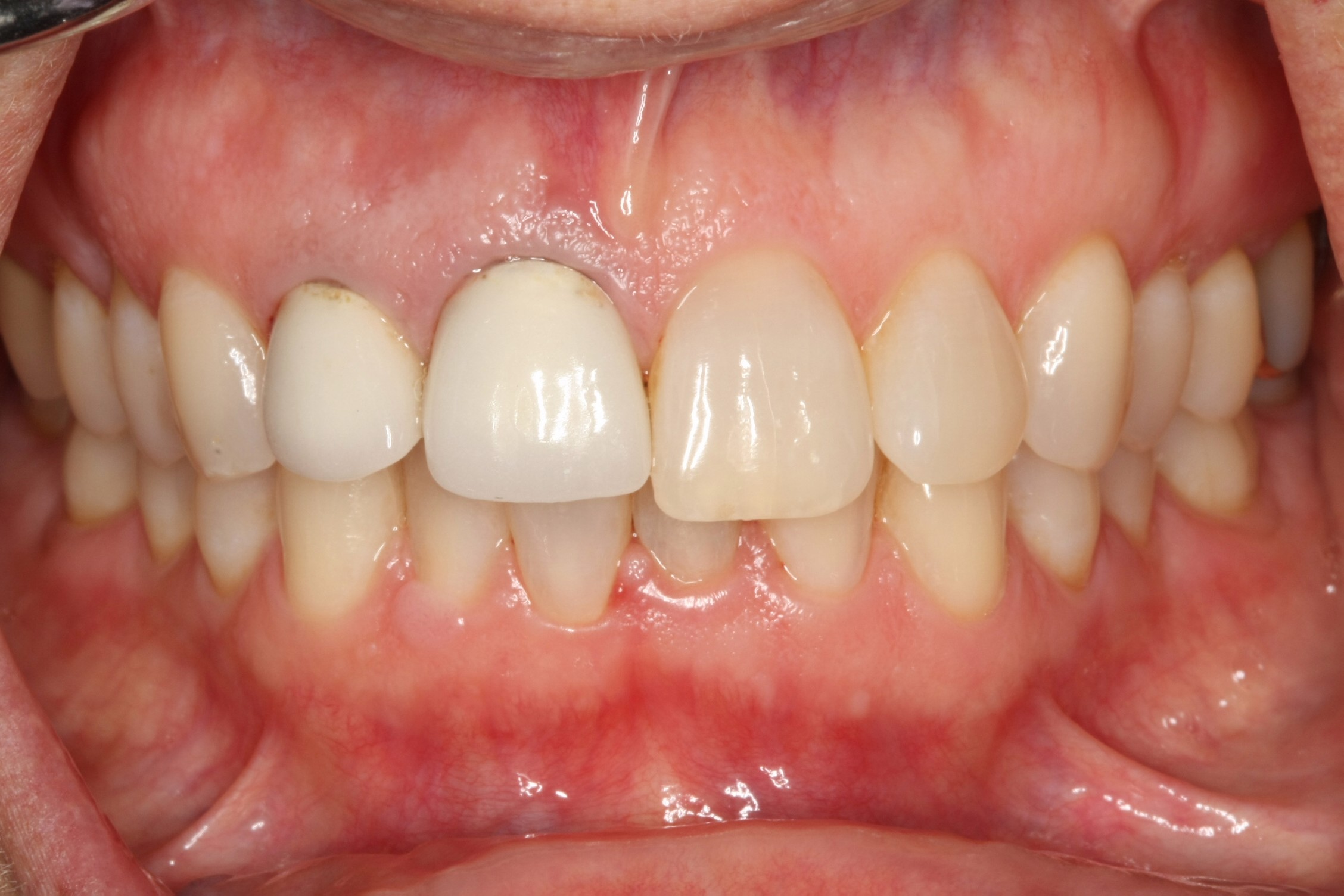
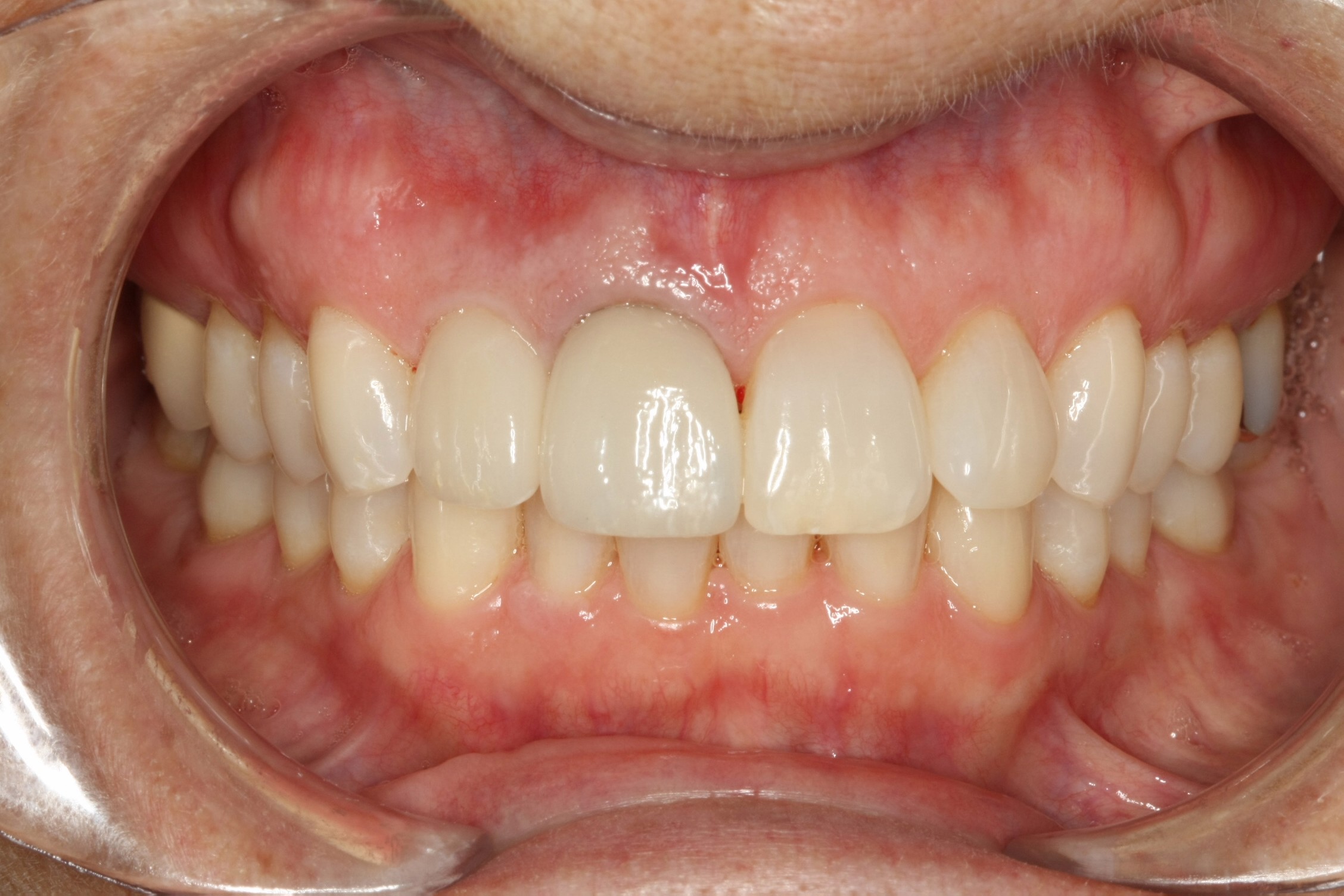
Implant & Restorative Case #2
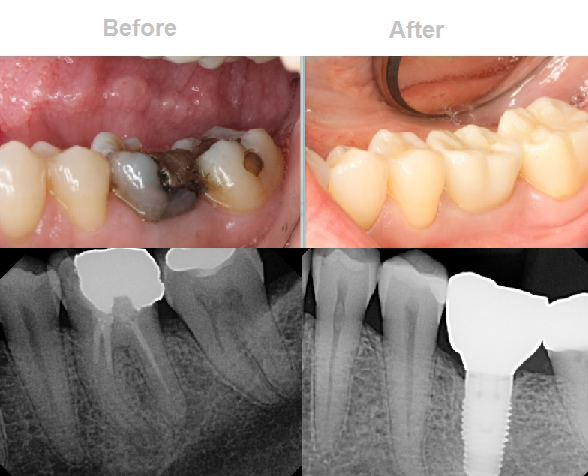
Root Amputation
Root amputation is a specialized dental procedure, whereby one root is removed from a multi-root tooth. The tooth is then stabilized and rendered fully functional with a crown or filling. The multi-root teeth best suited to the root amputation procedure are the molars at the back of the mouth. These large flat teeth have either two or three roots depending on whether they are situated on the upper or lower jaw.
The general purpose of root amputation is to save an injured or diseased tooth from extraction. Most dentists agree that there is no better alternative than retaining a healthy natural tooth, and the root amputation procedure makes this possible.
When is root amputation necessary?
It is important to note that root amputation can only be performed on an otherwise healthy tooth. Even in the case of a “key” tooth, extraction will be performed if the tooth is diseased, badly fractured or otherwise injured. Suitable teeth for root amputation have a healthy tooth surface, strong bone support and healthy underlying gums.
There are several problems that may lead to root amputation including:
- Broken, fractured or injured teeth and roots.
- Embedded bacteria within the structure of the root.
- Severe bone loss in a concentrated area due to periodontitis.
- Tooth decay in a concentrated area of the tooth.

Sinus Augmentation Graft
A sinus augmentation graft procedure makes it possible for many patients to have dental implants when years ago there was no other option besides wearing loose dentures.
The maxillary sinuses are behind your cheeks and on top of the upper teeth. Sinuses are like empty rooms. Some of the roots of the natural upper teeth extend up into the maxillary sinuses. When these upper teeth are removed, there is often just a thin wall of bone separating the maxillary sinus and the mouth. Dental implants need bone to hold them in place. When the sinus wall is very thin, it is impossible to place dental implants in this bone. For this situation, Dr. Britten would recommend a sinus augmentation graft to create a stable bone environment for implants to be placed.
Lateral Sinus Lift:
Indirect Sinus Lift
This procedure is less invasive than the direct sinus augmentation lift and is performed by preparing the bone for the dental implant as normal. Once the floor of the sinus has been reached, bone is gently packed in the preparation and pressed upward. This motion will tent the membrane of the sinus upward and create additional room for the full length of the implant.
As with the sinus augmentation graft or direct sinus lift, care will be taken not to damage the sinus and this procedure will have no effect on sinus pressure or affect people that suffer from seasonal allergies.
Sinus Lift:

IV Sedation
SEDATION
Dental anxiety affects many patients and can hinder them from taking the next step to achieve their oral health care goals. Dr. Britten is highly trained and certified in both IV conscious sedation and oral sedation. He is one of the few Periodontists in the Tampa Bay area who offers IV sedation. Sedation dentistry can provide a calming experience for patients who have experienced high levels of anxiety related to dental treatment.
IV CONSCIOUS SEDATION
Intravenous (IV) Sedation helps even our most anxious patients remain relaxed and comfortable during procedures. Many patients feel as though they, “went to sleep” during the sedation. The goal of IV conscious sedation is not to provide general anesthesia but instead to allow our patients to remain conscious and relaxed with minimal risk during the procedure.
IV Sedation:
ORAL SEDATION
Is a prescription medication that can relieve anxiety patients feel before and during their dental exam. It allows patients to respond verbally and physically to directions all while in a very “restful” state. Patients using oral sedation will need to be driven to and from the procedure.
You may be a candidate for Sedation Dentistry if you have experienced any of the following:
- High Fear
- Had traumatic dental experiences
- Difficulty getting numb
- A bad gag reflex
- Very sensitive teeth
- A fear of needles and shots
- Aversion to the noises, smells, and tastes associated with dental care
LOCAL ANESTHETIC
For most periodontal procedures, a local anesthetic is utilized to numb the area being treated. Some anesthetics are short acting and others last several hours. Dr. Britten will determine which local anesthetics are best for the procedure.

